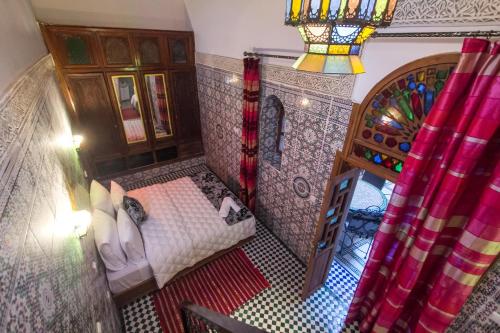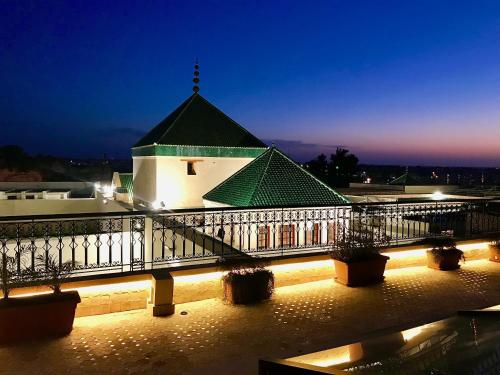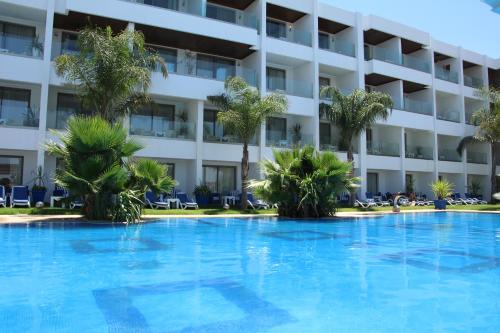I would never have expected to have found Roman ruins in Morocco but, here in the middle of nowhere, what remains of a large town rises out of the countryside.
You can see the archaeological site of Volubilis from kilometres away. Even though this is quite a mountainous region of Morocco, the ruins are in an area of flat green plains and they’re easy to spot from the road as you approach or from the nearby town of Moulay Idriss.
Why are they here? This would have been pretty much the extremity of the Roman Empire. Not just across the sea… but then hundreds more kilometres inland.
It would have been hard to protect and you might’ve thought it would seem like a desolate and isolated outpost for the Romans based here.
Yet, it wasn’t. The fertile lands of this part of Morocco were beautiful and perfect for agriculture. This wasn’t some kind of exile – Volubilis was an exotic paradise.
Why is Volubilis important?
The city of Volubilis was an important settlement for the Roman Empire in the 1st century AD, serving as one of the most southwestern outposts. The ruins of Volubilis are now one of Morocco’s most important archaeological sites, with a large number of well preserved features.
Why was Volubilis abandoned?
The Romans abandoned Volubilis in 285 when it was considered too hard (and not important enough) to defend from local tribes. But the city was inhabited for many more centuries and wasn’t completely abandoned until the 11th century, when its residents moved to new Islamic cities like Moulay Idriss and Fez.
Is it worth visiting Volubilis?
Volubilis is not just one of Morocco’s World Heritage Sites, it’s also one of its most important historical landmarks. It makes a nice change from the medinas that otherwise dominate the country’s heritage, and is an interesting insight into the spread of the Roman Empire.
Although it’s been more than a millennium since people lived here, there’s still plenty that remains of Volubilis and, amongst the ruins, there are lots of different things to see.
For people visiting Volubilis, it’s easy to spend an hour or two, walking through the streets of this ancient settlement, evidence of its grandeur rising strikingly from the fertile lands.
As I’ve travelled through Morocco, exploring many of its historical and cultural sights, there has been a lot of similarity in what I’ve found – most of it is related to the period of successive Islamic dynasties that (coincidentally) began just near here.
But what Volubilis offers to travellers in Morocco is a peek into a much more distant past, and an era when this land would’ve looked very different!
If you’re coming from Fez, you might want to consider this convenient tour that includes Volubilis and Meknes.
History of Volubilis
There had been a community here at Volubilis from the 3rd century BC, in what was then the Mauritanian Kingdom. It was a small settlement, but an important one, with a defensive wall protecting about 12 hectares.
But it was really from the 1st century AD that it expanded dramatically under Roman rule.
In 40 AD, the Romans annexed this part of the country, and Volubilis was made a city and then later named as the capital of a province called Mauretania Tingitana.
Volubilis quickly grew to a size of about 40 hectares, with a huge construction campaign leading to new public and private buildings.
There was a basilica, a temple and even a triumphal arch – maybe not rivalling the one we know in Paris these days, but impressive for the time.
In 168, during the reign of Marcus Aurelius, a town wall was built, about 2.5 kilometres long and with forty towers and eight monumental gates.
It wasn’t just the public buildings which were striking here. Even the houses of the residents – many of whom were clearly wealthy from producing olive oil and selling the crops of this land – were fine structures with large mosaic floors.
I spot one of the mosaic floors as I walk around the site – still clearly visible and in very good condition considering its age.
But the same can’t be said for much of Volubilis, unfortunately, which has fallen into ruins.
The Romans only stayed until 285, when they left abruptly, probably because it was getting too hard to defend the city against local tribes. But people continued to live on the site for many centuries after that (although they didn’t use the buildings in the same way the Romans did).
Eventually, in the 11th century, Volubilis was completely abandoned as the last residents moved to other cities like Fez and nearby Moulay Idriss, as the new Islamic dynasties changed the cultural structure of Morocco.
Things to see at Volubilis
Despite its turbulent history, and the centuries of neglect since it was abandoned, there is still enough standing at Volubilis to appreciate how this ancient city would once have looked.
Although a tour of Volubilis is worthwhile to understand what you’re seeing, I take a different approach when I visit.
Instead of having someone tell me what each structure would have been and what it would have been used for, I want to use my mind to build up the walls and put the ceiling back on top.
I want to hear the noises in my head of a busy market square, of people rushing through the streets, and of the chants from the religious leaders.
The site has only been partially excavated but, even if archaeologists tried to put it back together, it would be impossible to return it to some sense of its original layout.
Many of the stones used to build Volubilis were looted by later Moroccan rulers to build their own cities and magnificent palaces and landmarks, especially in Meknes
But there are still some notable things to see in Volubilis, and it’s worth taking some time to see these main sights:
- Triumphal Arch: The arch spans the main street and marks the point where the Romans began to expand the city to the northeast. It was once decorated with figures of the four seasons and had an image at the top of the emperor in a gilded chariot with six horses.
- Basilica: The basilica is one of the public buildings that was one the edge of the small forum area, where there was also a market and a capitol.
- Thermal Baths of Gallienus: Although there would’ve been thermal baths in the forum, this other set of nearby baths are better known and better preserved.
- House of Orpheus: There are good mosaics here, but the most significant part of this large private house are its well preserved olive presses and mills.
- House of Ephebe: Named after the statue of a young man discovered here, this is one of the best examples of the Roman peristyle house.
- House of the Train of Venus: Probably the most impressive of all the private houses in the city, there are eight rooms and seven corridors decorated with floors mosaics of myths.
- Palace of Gordian: Another of the city’s largest establishments, it’s thought this was probably the home of the Imperial procurator.
On a bright and warm day, like the one when I visit, I do look at the individual parts of Volubilis and think about how they fit together. But I’m also trying to get an overall sense of the city, which I think is also important.
In total, it takes me more than an hour to explore all the different areas, including climbing up to a stone platform in the central square and looking out over the piles of rocks to the green fields that lay beyond them.
This landscape is also an important part of the site. What you see now is not too different to how it was back in the 1st century. Olives was the main produce then and I’m sure there are still some olive trees out there.
Visiting Volubilis
You can visit Volubilis either independently or as a tour, and I’ll give you a bit of information about both of those options.
I come on my own, for instance, and as I walk through the main entrance, there are a few men working as unofficial guides here. They must have some kind of agreement about taking it in turns to approach tourists because only one of them starts talking to me.
He offer his services and I politely decline. He is insistent, following me and explaining why it would be better to go with him.
I decline again and he becomes a bit more forceful, suggesting a price. He is not aggressive and I’m sure it would be an interesting way to explore the ruins, but I want to be alone and he eventually leaves me.
One of the trickiest things about visiting Volubilis independently is getting here. There is, in theory, public transport by bus from Meknes, but it’s not obvious how to use it. Most people going from Meknes to Volubilis will use a grand taxi, but that can take time.
If you’re staying in Fez, I actually think the easiest thing to do is join this group tour. You have the option of using a guide or not as part of the tour. Either way, it has convenient transportation to both Volubilis and Meknes as part of the same trip.
There are some other good options, including private tours, here:
While you’re here, I think it’s definitely worth also seeing the town of Moulay Idriss, just a few kilometres away. It’s a fascinating place and there are quite a few things to see in Moulay Idriss. You could even stay here overnight, if you’re not in a hurry.
Just like Volubilis itself, Moulay Idriss is something a little bit different than the usual Moroccan tourist sites, and seeing this part of the country gives you a different perspective of its cultural and heritage.
Where is Volubilis?
The archaeological site of Volubilis is in the north of Morocco, about 50 kilometres west of Fez and 20 kilometres north of Meknes.
The closest town is Moulay Idriss, just three kilometres away. You can see it on a map here.
How do you get to Volubilis?
If you’re travelling by public transport, the best options are from Meknes, which can be reached by train from other parts of Morocco.
From Meknes, you can catch the bus number 15, which comes once or twice an hour. Another good way to get to Volubilis from Meknes is with a grand taxi, which should cost about 15dh to Moulay Idriss (remember, you’ll need to wait until the car is full).
From Moulay Idriss, you can walk to Volubilis, which is only about 30 minutes away, or there are taxis in town.
When is Volubilis open?
The archaeological site of Volubilis is open every day from 08:30 until an hour before sunset.
How much does it cost to visit Volubilis?
Entry to Volubilis costs 70dh (US$7) per person.
Are there tours to Volubilis?
There are tours to Volubilis from Fez and, unless you’re planning to stay overnight in Moulay Idriss, I would recommend taking one, because they’re affordable and you’ll save a lot of time.
There is this group tour from Fez where you can choose to have a guide or not, and there’s also this private tour from Fez. Both include time in Meknes as well.
As you’ll see when you visit, this is a beautiful part of the world. It certainly wouldn’t have been an awful exile for those Romans who came here almost two millennia ago, far from the political and military clashes that their peers back in Central Europe would have been dealing with.
Even today, there are many Europeans who are buying grand holiday houses in Morocco. Perhaps Volubilis wasn’t too different to that back then!
THE BEST ACCOMMODATION IN MEKNES
I would recommend basing yourself in Meknes to visit Volubilis (although nearby Moulay Idriss is another option).
BACKPACKER

With cheap rooms near the train station, Mille Et Une Nuit is a good riad for backpackers.
BUDGET

For a budget option, Dar Meknes Tresor has comfortable rooms and a delicious breakfast.
BOUTIQUE

For something a bit more modern, Riad Zidania has renovated rooms and a wonderful terrace.
LUXURY

You’ll find very comfortable luxury at the four-star Zaki Suites Hotel on the edge of the medina.
I love the pics. Great read.
Thanks, Laura. I don’t think it’s a particularly famous place but it’s really worth a visit. Glad you liked the photos.
Bon soir
pays grandiose donnez mois de conseilles lieux hôtel les meilleurs dates a venir visiter ces cites grandioses
Été l’année dernière a Marrakech pays de rêves
Pourriez vous mieux centrée vos photos ,ou s’agit il de mon imprimante
Merci d’avance
Très Cordialement
Yves Bourreau
Hi Michael,
Your article has swayed me to visit Volubilis. We will actually be in Chefchaouen in October and now decided to take a private car from there and drive 6 hours RT to Volubilis. All my hotel accommodations have been made, so I can’t really change anything. Am I crazy? Will it be tiring to do this in one day? Would love your perspective and suggestions,,,